Wolf
![]()
The title of this article is ambiguous. For other meanings, see Wolf (disambiguation).
The wolf (Canis lupus) is the largest recent predator of the dog family (Canidae). Wolves usually live in family groups, technically called packs. The main prey in most regions are medium-sized to large ungulates. The species has been distributed in several subspecies throughout Europe, much of Asia, including the Arabian Peninsula and Japan, and North America since the late Pleistocene.
Wolves were systematically persecuted in Central Europe from the 15th century onwards, and by the 19th century they had been severely decimated in almost all regions of their worldwide range, mainly through human hunting, and were almost extinct in Western and Central Europe, and completely extinct in Japan. Since the 1980s, the wolf has been under protection in many countries. In European states by the Bern Convention, in the EU since 1992 additionally by the regulations of the Flora-Fauna-Habitat Directive. In many countries, including the Middle East, there is no legal protection for the wolf.
Since the turn of the millennium, the number of wolves and wolf packs in Central and Northern Europe has increased significantly again. For the 2019/20 survey period, wolves in Germany were registered in 128 packs, 35 pairs and 10 territorial individuals living in 173 wolf territories. Wolves are among the best-known predators; they found their way into the myths and fairy tales of many peoples early on. They are the ancestral form of all domestic dogs and the secondary wild dingo.
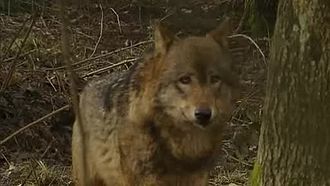
Play media file Close ups of a wolf
Features
General features
Basically, the wolf resembles a large domestic dog, although the torso is longer and the rib cage is higher but narrower compared to similarly built domestic dogs. Wolves are comparatively slender with long legs. The head is relatively large with a broad forehead, long muzzle, and short, erect ears that are densely hairy on the inside and point forward. The eyes are set obliquely and are also oriented forward. The bushy tail has about one third of the head-torso length.
Body sizes and weights of wolves are very different due to the extensive distribution area and partly follow Bergmann's rule. Wolves reach head-torso lengths of mostly 1.0 to 1.6 meters and tail lengths of mostly 35 to 56 centimeters. The weight, which is also very variable within subspecies, is usually in the range of 13 to 78 kilograms; weights over 60 kilograms are rare, but North American wolves can reach 80 kilograms. Males (males) are on average larger and heavier than females (females). Shoulder height measures 66 to 91 centimeters; hind foot length 23 to 27 centimeters. The length of the relatively small, triangular ears is nine to twelve centimeters. The largest wolves live in central northern Russia and in Alaska and Canada. The smallest wolves live in the Near East and the Arabian Peninsula; the minimum of their head-torso lengths is only 82 centimeters. Male Polish wolves from the Białowieża Jungle had a mean head-torso length of 119 centimeters and a shoulder height of 70 to 90 centimeters; females from the same area had a mean head-torso length of 111 centimeters (extremes: 97 and 124 centimeters) and a shoulder height of 60 to 80 centimeters. Males from southeastern Poland weighed 35 to 67 kilograms, females 27 to 50 kilograms.
The coloration is very variable, there are white, cream, yellowish, reddish, brown, gray and black wolves. In the temperate zones of Europe and Asia, grey-yellow or brown-grey wolves predominate, the northern populations show larger proportions of black and white animals. Dark hairs usually predominate on the back and tail. The belly, legs and muzzle are usually much lighter in colour. According to genetic studies, the black coat color in wolves is based on a mutation that first occurred among domestic dogs and later entered the wolf population.
Skull and skeletal features
The skull of the wolf is elongated, it has a total length of about 21 to 25 centimeters, making it longer than the skull of any other type of dog. The nasal bone is slightly dented over the entire length. The dentition of the wolf consists of three incisors (Incisivi), one canine (Caninus), four premolars (Praemolares) and two molars per half of the upper jaw, as in all dogs, and three incisors, one canine, four premolars, but three molars per half of the lower jaw. In total, wolves have 42 teeth. The premolar P4 in the upper jaw has a length (not to be confused with the height) of more than 20 millimeters, it is called fang and forms in interaction with the molar M1 (also called fang) of the lower jaw a crushing shear. The molar M2 in the upper jaw has a chewing surface of more than 100 square millimeters, which is not reached by any other dog species. Like all dogs, the wolf also has a penis bone (baculum). This is pointed and has a continuous notch.

The fur in the area of the muzzle is often whitish with wolves, over the eyes they often carry bright spots; the upright ears are short and densely hairy
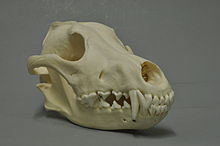
Wolf skull. The zygomatic arch below the orbit is widely projecting, the crest on the top of the skull is clearly formed.
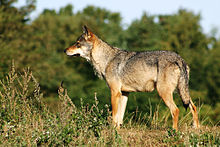
The outline of the torso and legs of a wolf forms approximately a square. The back and upper side of the tail are often dark colored
Differences from the domestic dog
Domestic dogs are domesticated forms of the wolf and therefore belong to the same species (Canis lupus) as the dingo. The distinction between wolves and domestic dogs is mostly possible on the basis of some characteristic features, whereby the extent of the differences varies greatly depending on the dog breed. The muzzle is usually shorter in domestic dogs than in wolves. Wolves often have a light patch over the eyes, pale cheeks, and a whitish front of the neck; they often carry a dark saddle patch on their backs. The eyes are yellow to yellow-green and slanted. The always erect ears are usually smaller than those of domestic dogs. Due to the longer legs compared to the domestic dog, the body outline in profile (without head, neck and tail) corresponds approximately to a square; the body outline of domestic dogs, on the other hand, corresponds to a rectangle, which is longer than high. Wolves usually let their tail (tail) hang down when at rest; domestic dogs often carry it up or curled. In some cases, however, only DNA analysis can determine beyond a doubt whether an individual is a wolf, a domestic dog, or a hybrid with ancestors from both sides.
Morphological and anatomical differences
Wolves have a violet gland at the tail-upper side, that is missing with many house-dogs or appears vestigially, with others, however, a wide gland-field forms. Especially at the skull, numerous differences between wolf and domestic dog can be found. Wolf skulls have a higher crest compared to domestic dog skulls, which serves as an attachment point for the masticatory muscles. The profile of a wolf skull is slightly flatter in the forehead area than that of a domestic dog. The lower incisors are usually closer together in the wolf than in the domestic dog. The length of the fang in the upper jaw (the premolar P4) is less than 20 millimeters in the domestic dog. The projecting zygomatic arches of the wolf allow a straight line assumed from the zygomatic arch to the roof of the skull to rise at a smaller angle than in the domestic dog, whose zygomatic arches lie closer together. Between this straight line and the plane of the skullcap, there is an angle (called the orbital angle) of 40 to 45 degrees in the wolf, and 50 to 60 degrees in the domestic dog.
Other differences
Female wolves become fertile only once a year, they are monooestrous, domestic dogs up to twice, they are diestrous. Male wolves produce reproductive sperm only during the mating season in winter and early spring. Domestic dog males, on the other hand, are in principle capable of reproducing at any time. Because paw prints with five-piece pads are similar and cannot be distinguished beyond a doubt based on size, tracks are often assigned based on their course. In the snow, wolves place their hind paws in the prints of the front paws - they lace - in the pack they often run behind each other and place their paws in the prints of the front wolf. Then you get the impression that you are following the track of a single wolf, until suddenly the track splits into several individual tracks. The course of a wolf track is also often straight and goal-oriented over hundreds of meters, while for dogs running around and deviating is typical.
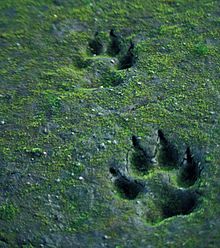
Tread seal of a wolf on superficially dried, sodden ground
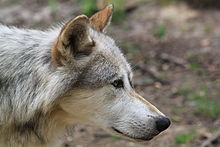
The muzzle of a wolf is long, its neck muscles are strong. The head is often held at the level of the back
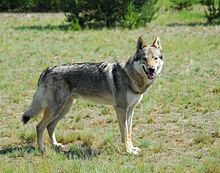
Czechoslovakian wolfhounds look very similar to wolves, but they have a slimmer abdomen
Questions and Answers
Q: What is a wolf?
A: A wolf is a mammal belonging to the order Carnivora, also known as Canis lupus, and is the ancestor of the domestic dog.
Q: What other common names are wolves known by?
A: The common names for wolves include timber wolf and grey wolf.
Q: Where did the domestic dog come from?
A: The domestic dog is descended from wolves that were tamed less than 16,300 years ago south of the Yangtze River in China.
Q: Are there different subspecies of wolves?
A: Yes, there are many different wolf subspecies, such as the Arctic wolf.
Q: Are any wolf subspecies endangered?
A: Yes, some wolf subspecies are listed on the endangered species list.
Q: How is Canis lupus graded by the IUCN?
A: Canis lupus is graded by the IUCN as 'least concern' overall.
Q: What is the order that wolves belong to?
A: Wolves belong to the order Carnivora.
Search within the encyclopedia